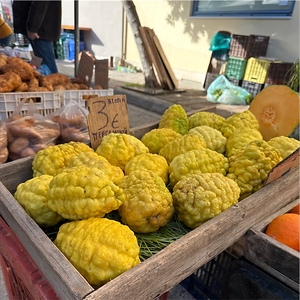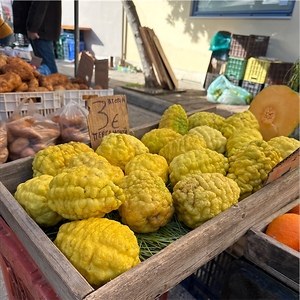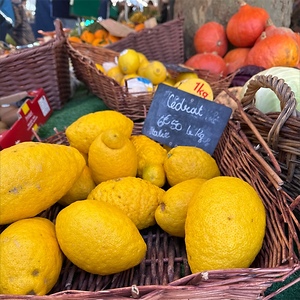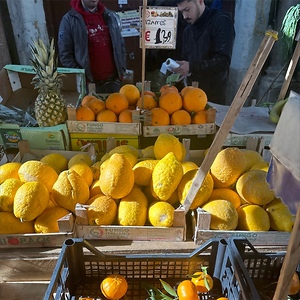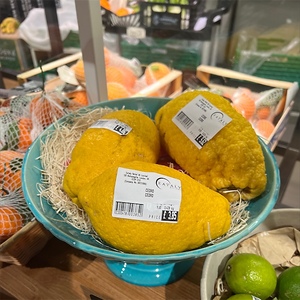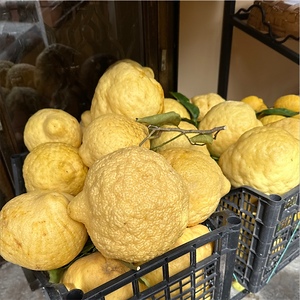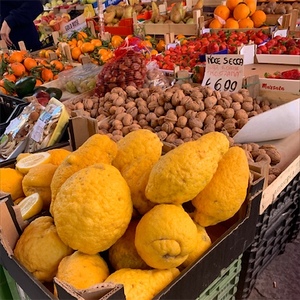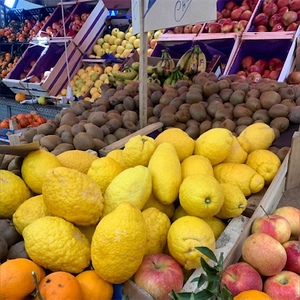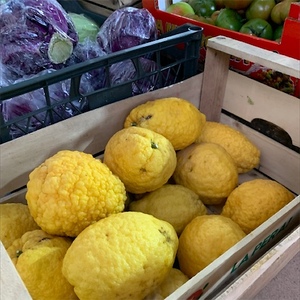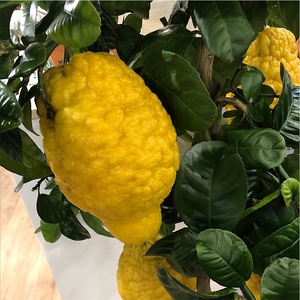

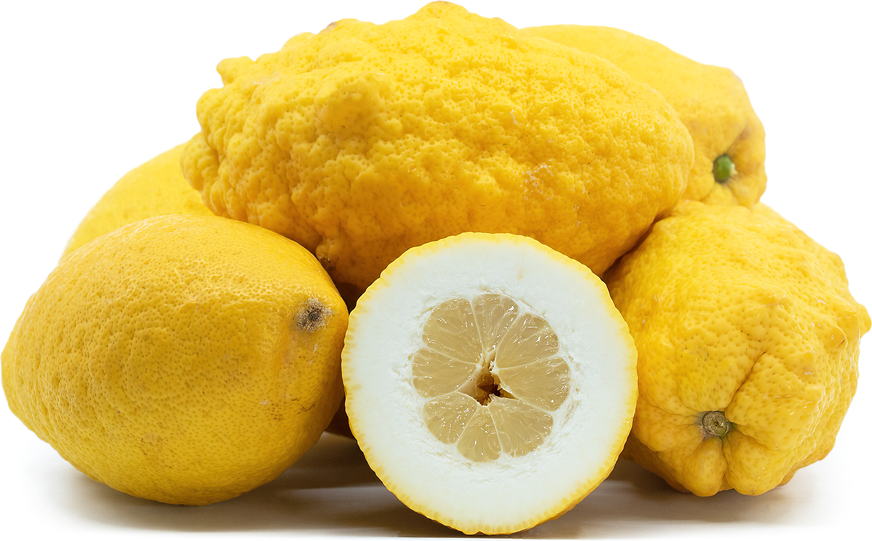
Cedro Citrons
Estimated Inventory, ea : 0
Description/Taste
Cedro is a large citrus species, averaging 10 to 11 centimeters in diameter and 17 to 30 centimeters in length, and has an elongated to oval shape with tapered ends, sometimes exhibiting a pronounced mammilla opposite the stem end. It is important to note that the fruit's size and shape are variable, depending on cultivation, and some fruits can grow much larger, occasionally as big as a football. The fruit's peel is covered in bumps, grooves, wrinkles, and folds, creating an irregular, textured feel. The peel also ripens from green to bright yellow and is enveloped in prominent oil glands giving the surface a pebbled, glossy appearance. Underneath the yellow exterior, a thick layer of white pith encases a small amount of flesh. The pith is spongy, dry, and fragrant, comprising around seventy percent of the fruit. The pale yellow flesh has large vesicles that contain little to no juice and are divided into segments by membranes. Like lemons, the flesh is soft, semi-tender, and pulpy, containing a few to many seeds, depending on the variety. Cedro releases an aromatic scent reminiscent of lemons. The pith is sweet, and the flesh is acidic, tart, and sour, but the flesh is typically milder in flavor than common lemons.
Seasons/Availability
Cedro is available year-round, with a peak season in the fall through winter.
Current Facts
Cedro, botanically classified as Citrus medica, is an ancient citrus species belonging to the Rutaceae family. The large, wrinkled fruits have been cultivated for thousands of years and have been planted in civilizations worldwide, utilized as a culinary ingredient, medicinal remedy, and religious symbol. The species is also one of the four original varieties of citrus that have historically been used for breeding modern citrus cultivars. The name Cedro is the term utilized in Italy to describe several varieties of the fruit, but worldwide the species is most commonly known as Citron. There are three main categories of Cedro grown in Italy, including acidic, non-acidic, and pulp-less cultivars. Within each of these categories, there are multiple varieties of Cedro displaying varying characteristics. The most popular Cedro variety produced in Italy is Diamante, an acidic cultivar named after the town of Diamante in the province of Cosenza, Calabria. Unlike other citrus species, Cedro has very little juice and flesh and is traditionally used for its thick, white pith and oil-infused zest. The fruits can be used fresh or cooked, imparting an aromatic, citrusy fragrance into culinary preparations and specialty beverages.
Nutritional Value
Cedro is a source of potassium to balance fluid levels within the body, fiber to regulate the digestive tract, and magnesium to control optimal nerve functioning. The fruits also provide vitamin C to strengthen the immune system while reducing inflammation, iron to develop the protein hemoglobin for oxygen transport through the bloodstream, and other nutrients, including vitamin B6 and zinc. In natural medicines, Cedro was used in ancient times as a detoxifying element to cleanse the body and was made into a tea to reduce symptoms associated with colds and coughs. The volatile oils encased in the rind have also been used in cosmetics and perfumes. One element in the oil, known as limonene, is believed to have antimicrobial and antioxidant-like properties to protect the cells against the damage caused by oxidative stress and free radicals.
Applications
Cedro is primarily used for its thick pith and rind, which is filled with aromatic oils that impart a citrusy, lemon-like taste and scent. Before use, the fruit's rind must be washed and scrubbed free of any dirt. Once prepped, the Cedro can be sliced and sprinkled with sugar as a fresh snack or dessert. The entire slice can be consumed, including the peel, pith, and pulp, and the sugar helps to balance the acidity within the flesh. Cedro can also be infused into olive oil, simmered into marmalades, or chopped and mixed with herbs in bruschetta. In Italy, the peel is customarily candied and marketed as a regional sweet delicacy. When Cedro is candied, it typically develops a translucent green hue, and the chewy pieces can be added to desserts such as cannoli or panettone. Candied Cedro is also incorporated into a traditional Italian Easter cake known as wheat pie, made with ricotta, whole wheat berries, candied Cedro, and spices. Try adding Cedro into pastry filling and mixing with almond or vanilla extract to create a zesty recipe. Beyond sweet preparations, Cedro pith is sliced into small pieces and tossed with sugar and herbs as a bright and refreshing salad. The pith can also be combined with balsamic vinaigrette as a salad flavor variation. One of the most popular savory dishes utilizing Cedro is risotto. The citrus adds a lemon-like fragrance and is combined with herbs for added complexity. Cedro can also be pickled as a tangy condiment, processed into a liqueur similar to limoncello, infused into carbonated beverages, or simmered into syrups and stirred into cocktails. Cedro pairs well with herbs such as fennel, sage, mint, and basil, celery, tomatoes, vanilla, maple syrup, and nuts such as almonds, pecans, hazelnuts, and pistachios. Whole, unsliced Cedro will keep for 2 to 4 weeks when stored in a cool and dry place away from direct sunlight. In the refrigerator, the fruit will last for 3 to 8 weeks.
Ethnic/Cultural Info
In the southern Italian region of the Riva dei Cedri or the Citron Riviera, the town of Santa Maria del Cedro is centered around Cedro. The town is situated on the Northern Tyrrhenian coast between Scalea and Diamante and is known for its ideal microclimate for producing citrus. Cedro production is so widespread in the area that in 1968, the town changed its name from Santa Maria to Santa Maria del Cedro to showcase the region's agricultural lifeblood. The Diamante Cedro is the most cultivated variety within Santa Maria del Cedro, and the citrus species is protected by the Consorzio del Cedro di Calabria, a group of Cedro advocates who promote the species through events and knowledge shared at the Museo del Cedro, a museum just outside of the town. Each year in Santa Maria del Cedro, there is a pilgrimage of Jewish officials who visit the town to collect specific Cedro fruits for use in the Jewish fall religious holiday Sukkot, also known as the Feast of the Tabernacles. Cedro is known as Etrog in Hebrew, and the fruits are typically collected between July and August. Etrog is used in prayer during the 7-day festival to commemorate the protection of the Israeli people in the wilderness and was believed to be the "fruit of the Godly tree" mentioned in Leviticus of the Old Testament. In the morning prayers, Etrog is held in one hand while willow branches, palm branches, and myrtle branches are waved in every direction to symbolize unity. When the Jewish officials arrive in Santa Maria del Cedro, they arise at 5 AM and venture into the orchard to find Cedro considered kosher. The Cedro trees are hand-inspected to ensure they have not been grafted, and fruits are examined for their appearance and remnants of the flower, known as the pitam, still attached on one end. Thousands of Cedro are harvested, wrapped, and packed in boxes for transport out of the country for Sukkot celebrations, and one fruit can be sold for over $100, depending on its visual qualities.
Geography/History
Cedro, more commonly known as Citron, is native to the central Himalayan foothills and has been growing wild since ancient times. It was in this region that experts believe Citron was first domesticated, and over time, the species was carried with traveling merchants as it exhibited extended storage properties. Citron was eventually introduced to Western Asia and the Middle East, where pollen grains were discovered in a Royal Persian Garden dating back to the 5th and 4th centuries BCE. Citron was also carried into the Mediterranean and was first mentioned in writing by Theophrastus in his book Enquiry into Plants, a piece completed in the 4th century BCE. For many years Citron was not viewed as an edible fruit and was grown in gardens as a medicinal ingredient, household cleaner, or for its fragrant oil. The species was planted in southwestern Italy sometime around the 3rd century BCE, and since its introduction, Citron has thrived along Italy's western coast, especially in Calabria, the Amalfi Coast, Sicily, and Sorrento. Today Cedro is grown year-round in Italy and is sold through local markets, distributors, and select grocers. The fruits are also exported to other countries in Europe and are grown on a small scale in California and Australia.
Recipe Ideas
Recipes that include Cedro Citrons. One
| Sorrento Food Tours |
|
Cedro Lemon Risotto |
| Jamie Oliver |
|
Cedro Lemon Bruschetta |



